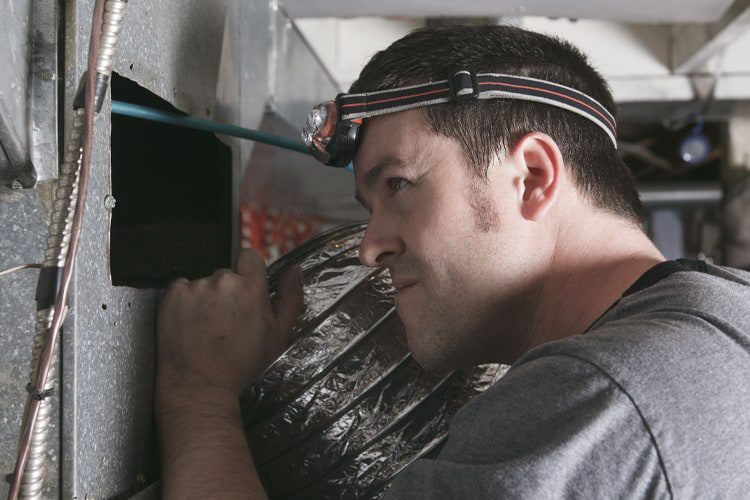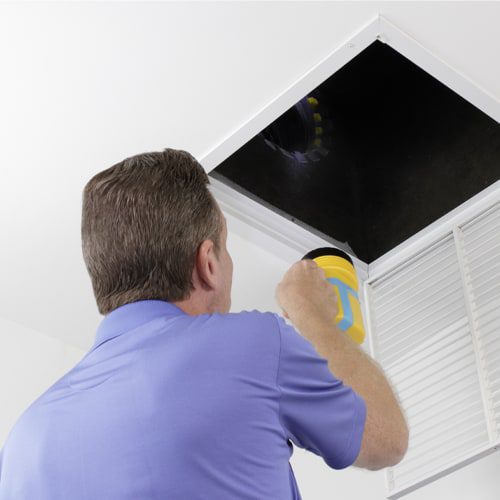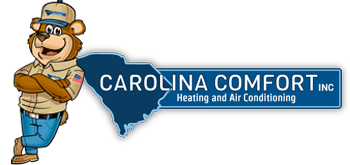IS IT TIME TO REPLACE YOUR DUCTWORK?
Have you noticed your air conditioner never reaches the temperature you set it to? While there are several things that could be causing your HVAC system to operate inefficiently, one of the first things you should check is your ductwork.
Ductwork is a big part of an efficient HVAC system. If your ductwork is installed incorrectly, not designed for use with your particular HVAC system, or has leaks that have occurred in installation or over time, it could have significant impacts on how well your HVAC system keeps up and how much it costs to run.

Is It Time to Inspect Your Ductwork?
It’s time to take a good look at your HVAC ducts if:
- You first move into a home, unless you are familiar with the builder and their practices.
- You notice that the HVAC system can’t keep up with your demand for heat and cooling.
- You had a new HVAC unit installed and it doesn’t seem to be performing as well as it should.
- You notice that your energy bills seem to be higher than they should be.
- You hear a lot of noise in your ducts when your air conditioner or furnace is running.
- You notice air coming through grates or vents when the HVAC unit is turned off.
If you have any of these situations you should assess your ductwork for leaks, insulation, and size. Read on for some guidelines of what to look for while inspecting your ducts and when to get help for installation or repair.
Ductwork Inspection Checklist
Especially if you haven’t run the HVAC system much since you moved into the house, it can be a good idea to have a professional HVAC expert inspect your HVAC system. However, there are many things that you can check for yourself to determine if you need an HVAC tech to come to your home for repairs or replacement of your ducts.
Use these steps when assessing your duct system:
- Put your hand over vents, registers, and grates while the fan on the HVAC unit is off to see if you feel any moving air. (You shouldn’t.)
- Visually inspect exposed or assessable ductwork for potential cracks or leaks.
- Check to make sure that ducts in unconditioned areas are well insulated.
- Listen to your ducts with the fan running. If working properly they should be fairly quiet if not completely silent.
- Check the home for hot and cold spots, as this can be an indicator of poor airflow.
Of course, there are some things that should be checked in your ductwork that must be handled by a professional with the appropriate equipment. If you have a technician come to your home to assess your ductwork, they should check several additional things, including:
- Evaluate air balance in the system.
- Conduct a combustion safety test to ensure no back-drafting of natural gas or other fuel.
- Inspect the size of the ductwork as it compares to the size of the HVAC system and the demands.
- Conduct duct pressure testing.
By inspecting these items, you and your HVAC technician can determine if your ductwork was installed properly, is the correct size for your HVAC system, or needs repair. In some cases of poor installation, the ductwork may need to be taken out and completely replaced for the sake of the efficiency of your system.
Common Problems Caused by Poor Duct Installation
Unfortunately, the ductwork in most homes is not adequate for the HVAC system installed. In fact, many duct systems are poorly designed with far too small ducts that are inefficient at moving air throughout the home. Here are some of the most common problems that can result from improper installation.
Improper Airflow
Unbalanced duct systems will allow conditioned air to be pushed outside, while outdoor air is pulled into the home. This can decrease the energy efficiency and effectiveness of your HVAC system. It decreases air quality, increases energy costs, and can lead to building pressure issues.
Ductwork in Unconditioned Spaces
Best practices for ductwork installation require technicians to install ducts within conditioned areas as much as possible. Ducts should not be located in unconditioned areas such as the attic, basement, or crawlspace. If it is in these areas, it should be well insulated to prevent leaks. Ducts in these areas can lead to reduced indoor air quality as well as pressure imbalances.
Building Cavities Used as Return Air Ducts
This is unfortunately quite common, but it is one of the worst things that you can do for your HVAC system. When building cavities are used as return air ducts, it can introduce contaminants into the air in your home. These practices can also lead to pressure problems with the system.
Improperly Sized and Designed Duct Systems
Your ductwork will only be as efficient as its design. Ductwork is designed and installed when the home is first built, or later as part of HVAC installation. When ductwork is not sized properly for the HVAC system or the demands of the home to be conditioned, it can cause pressure issues and restricted airflow.
Replacing Your Ducts with New Installation
Some minor issues with ductwork can be resolved with simple repair, such as sealing leaks and registers. However, there are many reasons that you might want to consider replacing your ductwork altogether. Replacing your ducts is an investment that could have a significant impact on your budget in the future.
First, if you replace your ducts completely, you can ensure that you have a system designed for optimal efficiency with your current or newly installed HVAC system. Often you can get more efficiency and life out of your HVAC system if you have a good duct system in place.
Second, if you have ducts in unconditioned places in the home, or if your system is making use of natural cavities in the home for air return, it is best to completely replace the duct system instead of trying to repair each section that requires attention. By starting over from scratch, your HVAC professional can design and size the ducts to work best with your system.

Finally, if you have an older home that has an upgrade in HVAC equipment but not an upgrade in ductwork, your ducts could be completely unsatisfactory for the demands you are placing on it. Replacing your ducts with a new system that is better designed and sized appropriately for your unit will also help improve efficiency and lengthen the life of your HVAC unit.
When you have a technician install new ductwork in your home, you should make sure that they follow some specific steps outlined below.
- Inspect return air ducts, registers, and vents to ensure they are the appropriate size for the new duct system, replacing them if necessary.
- All connections should be sealed, including connections between the ducts and the registers or vents.
- If it is necessary to locate some ducts outside conditioned areas, these ducts should be well insulated.
- Install a new filter in your HVAC system.
Your HVAC professional should also make sure that they do certain testing after the installation of your ductwork is complete. These tests should include an evaluation of airflow and pressure throughout the entire system, as well as a combustion safety test after sealing is complete. Performing these extra steps ensures that the duct system has been installed properly for the best efficiency.
It is a good idea to get ductwork replaced whenever you replace your air conditioner. If you are having your ducts checked and you have an older HVAC unit, or you don’t know the age of the unit, you should talk to your technician about installing a new AC unit as well as new ductwork. In this way the entire system can be designed to work together for maximum efficiency, better indoor air quality, and lower energy bills.
Expert Consultation – Only A Call Away!
Carolina Comfort, Inc. has been serving the neighborhoods of Columbia, South Carolina for over two decades. This means that when it comes to air conditioning systems, we really know our business.
From assessing your cooling requirements to bringing down costs associated with faulty air conditioning units, Carolina Comfort, Inc. can serve all your AC related needs.
The best part is that we pride on being available 24/7 for our customers.
After all, air conditioning systems can stop working any time, and so our technicians are always available to deal with any AC related emergencies – whether it is a weekend, holiday, or the middle of the night!
If you have any questions, need a consultation, or someone to repair your air conditioning unit – call us now!

5636 Bush River Rd.
Columbia, SC 29212
SC License – #M104545
NC License – #32356
Phone: (803) 794-5526

